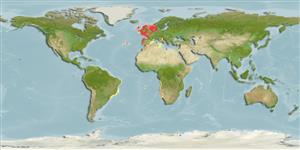Common names from other countries
Classification / Names / Names
Common names | Synonyms | Catalog of Fishes (gen., sp.) | ITIS | CoL | WoRMS
Environment: milieu / climate zone / depth range / distribution range
Ecology
Pelagic; depth range 0 - 500 m (Ref. 3292), usually 0 - 150 m (Ref. 3292). Tropical; 13°C - 21°C (Ref. 3292); 60°N - 27°S, 60°W - 15°E (Ref. 3292)
Atlantic Ocean and the Mediterranean.
Length at first maturity / Size / Weight / Age
Maturity: Lm ? range ? - ? cm Max length : 20.0 cm WD male/unsexed; (Ref. 2992)
Up to 20 cm wide; marginal lappets all alike, semicircular, thin; stomachpouches all of equal width, septa straight; in each octant 3 tentacles, all alike; exumbrella with 16 broad radial brown bands bordered by darker, narrow V-shaped lines; marginal lappets brown.
Usually found inshore, more dominant at dusk (Figure 3, Ref. 3292).
Life cycle and mating behavior
Maturity | Reproduction | Spawning | Eggs | Fecundity | Larvae
Members of the class Scyphozoa are gonochoric. Life cycle: Egg is laid by the adult medusa which later develops into a free-living planula, then to a scyphistoma to a strobila, and lastly to a free-living young medusa.
Kramp, P.L. 1961. (Ref. 2992)
IUCN Red List Status (Ref. 130435)
CITES status (Ref. 108899)
Not Evaluated
Not Evaluated
Human uses
| FishSource |
Tools
Internet sources
Estimates based on models
Preferred temperature
(Ref.
115969): 8.1 - 15.5, mean 10.8 (based on 1074 cells).
Resilience
High, minimum population doubling time less than 15 months (K=1.1-4.3).
Vulnerability
Low vulnerability (16 of 100).
Price category
Unknown.
